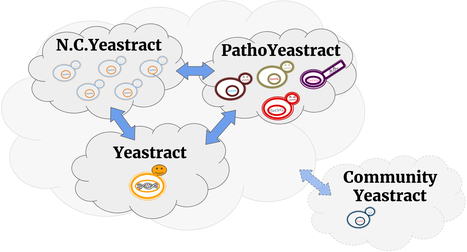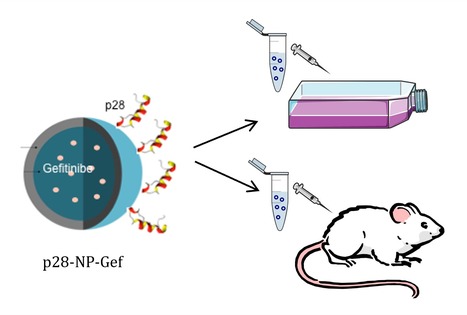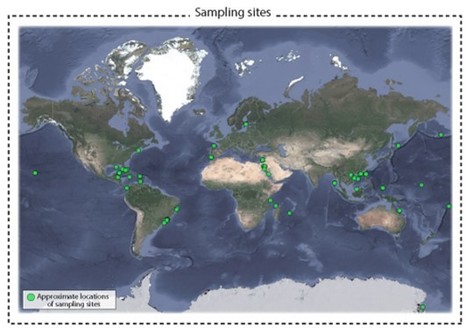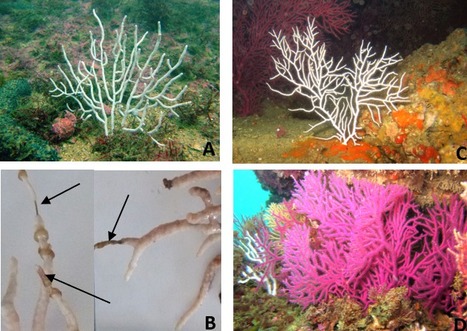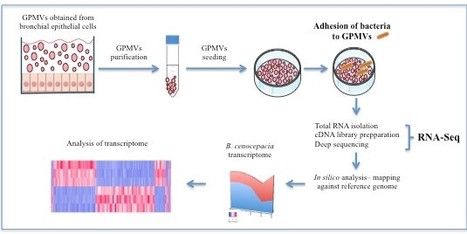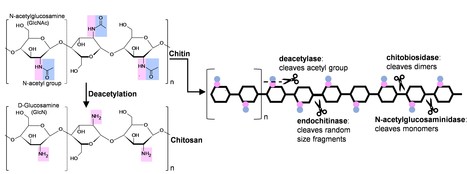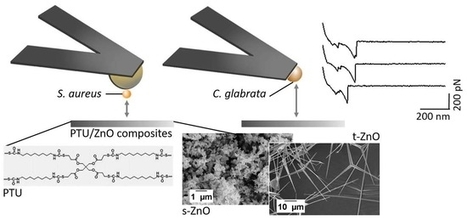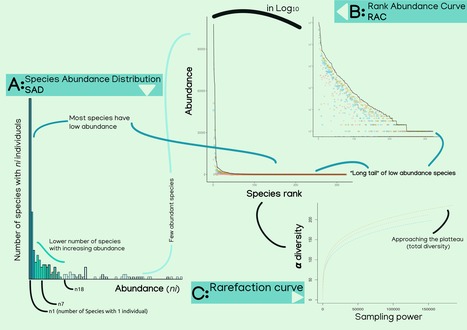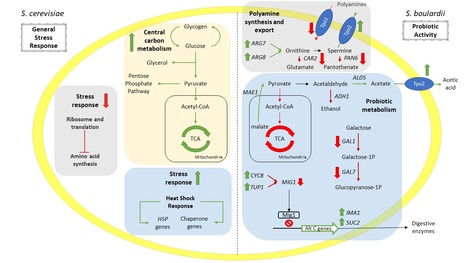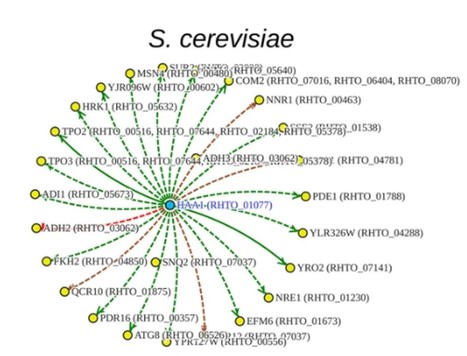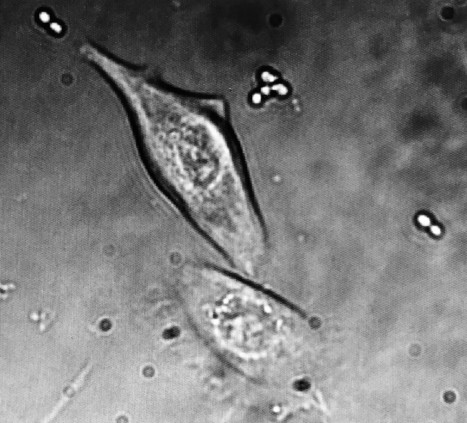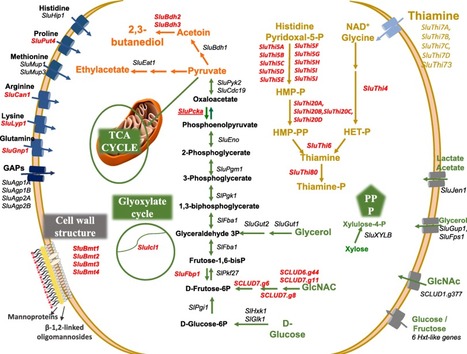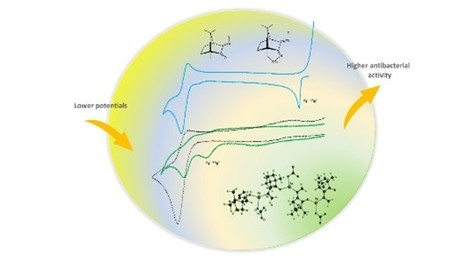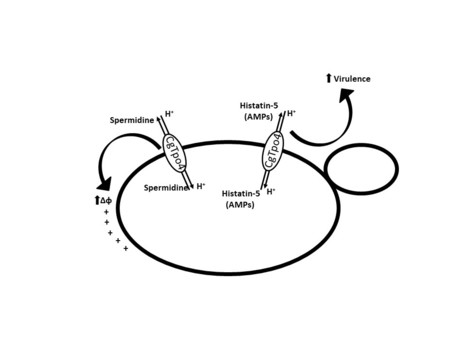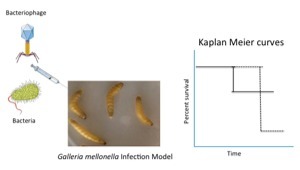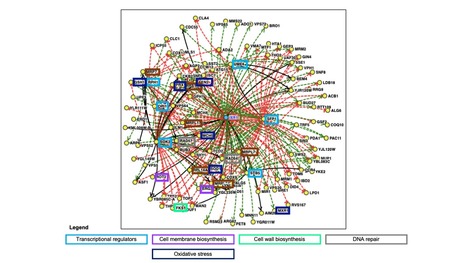 Your new post is loading...
 Your new post is loading...

|
Scooped by
iBB
January 10, 2022 11:17 AM
|
Exploring the Biological Function of Efflux Pumps for the Development of Superior Industrial Yeasts
The economic competitiveness of yeast-mediated bioprocesses in Chemical Biotechnology requires high tolerance of industrial strains to the multiple stresses that occur. Among the mechanisms used by yeast to overcome those deleterious effects is the activity of plasma membrane transporters involved in multidrug/multixenobiotic resistance (MDR/MXR). A new review article on these still poorly characterized transporters belonging to the MFS and the ABC Superfamily in yeasts of biotechnological relevance has just been published. The reported role of specific transporters in increasing the secretion of metabolites and other added-value bioproducts is also highlighted. The review article is co-authored by the BSRG-iBB researchers Isabel Sá-Correia and Cláudia P. Godinho and was published in the journal Current Opinion in Biotechnology (special Issue: Chemical Biotechnology 2022).

|
Scooped by
iBB
November 26, 2021 11:26 AM
|
Quantitative FRET Microscopy Reveals a Crucial Role of Cytoskeleton in Promoting PI(4,5)P2 Confinement
Phosphatidylinositol 4,5-bisphosphate (PI(4,5)P2) is crucial to many cellular processes in eukaryotes, including membrane trafficking, signal transduction, ion channel function and cytoskeleton dynamics. This function multiplicity is partially achieved through a dynamic spatiotemporal organization of PI(4,5)P2 within the membrane. In a recent paper published in IJMS, an IBB team (Maria J. Sarmento, Luís Borges-Araújo, Sandra N.Pinto, Nuno Bernardes, Joana Ricardo, Ana Coutinho, Manuel Prieto and Fábio Fernandes) was able to quantify PI(4,5)P2 confinement in living cells making use of FRET imaging measurements. PI(4,5)P2 was found to be significantly compartmentalized at the plasma membrane of HeLa cells. These PI(4,5)P2 enriched domains were shown to not depend on cholesterol content, ruling out an association with lipid rafts. On the other hand, upon inhibition of actin polymerization, compartmentalization of PI(4,5)P2 was almost entirely eliminated, confirming that the cytoskeleton network is the critical component responsible for the formation of nanoscale PI(4,5)P2 domains.

|
Scooped by
iBB
September 8, 2021 6:08 AM
|
Exploring N.C.Yeastract to Study Gene and Genomic Regulation in Non Conventional Yeasts
Responding to the recent interest of the yeast research community in non-Saccharomyces cerevisiae species of biotechnological relevance, the N.C.Yeastract was associated to YEASTRACT+, a curated repository of known regulatory associations between transcription factors (TFs) and target genes in yeasts. A recent Minireview published in FEMS Yeast Research aims to advertise the update of the existing information since the release of N.C.Yeastract in 2019, and to raise awareness in the community about its potential to help the day-to-day work on non-Saccharomyces species, exploring all the information and bioinformatics tools available in YEASTRACT +. Using simple and widely used examples, a guided exploitation is offered. The usage potentialities of the new CommunityYeastract platform by the yeast community are also discussed. The Minireview is coauthored by a BSRG-iBB team coordinated by Isabel Sá-Correia and including Cláudia P. Godinho, Margarida Palma, Miguel C. Teixeira and the PhD students Miguel Antunes and Marta N. Mota, in collaboration with INESC-ID colleagues.

|
Scooped by
iBB
September 3, 2021 10:37 AM
|
Gefitinib-Loaded p28-PLGA Nanoparticles Reduce Tumor Burden and Metastases in Lung Cancer
p28 is a 28 amino acids peptide derived from the bacterial protein azurin. It possesses cell-penetrating capabilities showing preferential enter in cancer cells. Moreover it has been subject in US to two phase I clinical trials as a anticancer agent. In a recent paper published in Journal of Controlled Release, a iBB team (Garizo AR, Dias TP, Fernandes F, Bernardes N, Fialho AM) together with a i3S/UP team (Castro F, Martins C, Almeida A, Barrias CC, Sarmento B) were able for the first time to fabricate p28-functionalized PLGA nanoparticles (NPs) loaded with the EGFR tyrosine kinase inhibitor gefitinib. The results obtained indicate that these NPs interact preferentially with lung cancer cells due to their decoration with p28 peptide. In vitro cytotoxicity assays demonstrate biological activity of the NPs against lung cancer cancer cells. Finally, in vivo studies demonstrated a great potential of the p28-NPs in enhancing the therapeutic effects of gefitinib.

|
Scooped by
iBB
June 23, 2021 9:51 AM
|
Insights into the Cultured Bacterial Fraction of Corals
Bacteria associated with coral hosts are diverse and abundant, with recent studies suggesting involvement of these symbionts in host resilience to anthropogenic stress. Combining published and unpublished data, a new article featuring iBB researchers Tina Keller-Costa and Rodrigo Costa among the authors provides a comprehensive overview of the diversity and function of culturable bacteria isolated from tropical, temperate, and cold-water corals. The study, published in the journal mSystems, compiles a total of 3,055 coral-associated isolates described in 52 reports from various laboratories around the world. The work presents a comparative genomic analysis of 74 strains and identifies signatures of potentially beneficial bacterium-coral symbioses among them. Such a resource is an important step in the selection of probiotic candidates, which are being investigated for promoting coral resilience and can potentially be applied in novel reef restoration and rehabilitation efforts. This genome and culture collection is available to the wider research community through the web site http://isolates.reefgenomics.org/ with the hope that many scientists across the globe will ask for access to these resources for future studies.

|
Scooped by
iBB
April 12, 2021 9:58 AM
|
Burkholderia cenocepacia BCAM2418-induced Antibody Inhibits Bacterial Adhesion
B. cenocepacia is a contact-dependent bacterium known for its capacity of causing respiratory infections. Among a panel of adhesins used by B. cenocepacia to contact with host cells, trimeric autotransporter adhesins (TAAs) are of particular interest. In a recent paper published in Cellular Microbiology, a BSRG-iBB team (Andreia Pimenta, Nuno Bernardes, Dalila Mil-Homens and Arsénio M Fialho) together with Michelle Kilcoyne and Lokesh Joshi from the National University of Ireland Galway, Galway, Ireland, were able to uncover the roles of the TAA BCAM2418, as an adhesin and the type of host glycans that serve as recognition targets. This work reveals the importance of BCAM2418 as a mediator of early host-bacteria crosstalk.

|
Scooped by
iBB
March 26, 2021 11:12 AM
|
New Metagenomic Insights Into the Octocoral Microbiome
Octocorals are marine invertebrates abundant in the Portuguese coast, which host complex microbiomes. Yet the functional relationship between host health and its symbiotic consortium has still to be determined. A new study from an international team led by iBB researchers Tina Keller-Costa and Rodrigo Costa employed comparative metagenomics to uncover the functional and phylogenetic features of the microbiomes of healthy tissue from three octocoral species from the Portuguese coast. The authors also explored how the octocoral microbiome shifts to a pathobiome state in one of the coral species. The study reveals that the octocoral microbiome is distinct from those of the environmental surroundings (that is, seawater and sediments), is host genus (but not species) specific, and undergoes complex structural changes in the transition to the dysbiotic state. Host-symbiont recognition, abiotic-stress response, micronutrient acquisition, and an antiviral defence arsenal comprising multiple restriction endonucleases, CRISPR/Cas systems, and phage lysogenization regulators are signatures of prokaryotic communities in octocorals. The authors argue that these features collectively contribute to the stabilization of host-microbe symbiosis in octocorals and constitute beneficial traits that can guide future studies on coral reef conservation and microbiome therapy. The article was published in the journal Microbiome.

|
Scooped by
iBB
March 14, 2021 8:09 AM
|
Burkholderia cenocepacia Transcriptome During the Early Contacts with Giant Plasma Membrane Vesicles
Burkholderia cenocepacia is a human contact-dependent pathogenic bacterium known for its capacity of causing severe opportunistic respiratory infections. B. cenocepacia uses a complex machinery for primary adherence with host cells. In a recent paper published in Scientific Reports, a BSRG-iBB team (Andreia Pimenta, Nuno Bernardes, Dalila Mil-Homens and Arsénio M Fialho) together with Marta M Alves from CQE, IST, have developed a RNASeq-based approach that led to identify adhesion candidate genes that were not previously reported in the context of a B. cenocepacia infection. This study presents a innovative technique in which their use Giant Plasma Membrane Vesicles (GPMVs) from a bronchial epithelial cell line as a cell-like alternative to investigate the steps involved in the adhesion process of B. cenocepacia.

|
Scooped by
iBB
February 17, 2021 5:45 AM
|
Chitin Degradation and Use Across Marine Microbiomes
Little is known about the structure and diversity of chitin-degrading microbial communities across marine niches. Researchers from BSRG-iBB, including PhD student Rúben Silva and former students Inês Raimundo (now a PhD student at KAUST) and Laurence Meunier (now a PhD student at University of Brussels), and led by Rodrigo Costa and Tina Keller-Costa have shed light on chitin processing within the microbiomes of marine sponges, octocorals, sediments, and seawater. The study, published in Microbiome, integrates cultivation-dependent and -independent approaches to unveil chitin degradation pathways across diverse marine bacteria. Functional metagenomics revealed that the marine sponge microbiome is rich in polysaccharide deacetylases, suggesting the ability of this consortium to convert chitin into its more biotechnologically versatile form - chitosan. The findings further suggest that chitin is processed via multiple mechanisms across marine micro-niches, favoring the hypothesis that inter-species microbial cross-feeding facilitates the co-existence of chitin users within the microbiomes of filter-feeding marine invertebrates. The study also reports on new chitinolytic enzymes from the genus Aquimarina that may find use in the blue biotechnology sector.

|
Scooped by
iBB
February 14, 2021 7:33 AM
|
Development of Anti-Fouling Materials that Reduce Microbial Pathogen Adhesion
The attachment of bacteria and other microbes to natural and artificial surfaces leads to the development of biofilms, which can further cause nosocomial infections. Thus, an important field of research is the development of new materials capable of preventing the initial adhesion of pathogenic microorganisms. In this work, novel polymer/particle composite materials were developed and characterized with respect to their mechanical, chemical and surface properties. Both S. aureus and C. glabrata exhibit a reduced capacity to adhere to the newly developed nanomaterials used in this study, thus showing their potential for bio-medical applications. This study, led by researchers from LAAS-CNRS, Toulouse, and co-authored by Mafalda Cavalheiro and Miguel Cacho Teixeira from BSRG-iBB, was just published in Nanomaterials.

|
Scooped by
iBB
January 29, 2021 11:11 AM
|
The Microbial Rare Biosphere and Ecosystem Functioning
It is now known that a significant fraction of the total microbial diversity in nature exists at low abundance, which has given rise to an increasing number of studies on the so-called rare biosphere. With the fast-paced improvement of novel molecular technologies, surveys on the dynamics of the rare biosphere across the three domains of life (Bacteria, Archaea, Eukarya) and several environments are now possible. Importantly, this research field is transitioning from a taxonomy-driven to a functionally driven analysis, whereby the roles of rare microorganisms in boosting ecosystem functioning are addressed. In this context, a team formed by Prof. Rodrigo Costa (iBB-BSRG), Prof. Catarina Magalhães (CIIMAR-ECOBIOTEC), and PhD candidate Francisco Pascoal (Porto University), delineate the state of the art in our current knowledge of the microbial Rare Biosphere, highlighting the role of viruses in the regulation of low abundance microbial populations. The review article, published in FEMS Microbiology Ecology, also examines current concepts and methods employed in the study of the rare biosphere, integrating emerging knowledge of low abundance microorganisms into a larger ecological theory framework.

|
Scooped by
iBB
January 23, 2021 11:59 AM
|
What Makes S. boulardii probiotic? A Transcriptomics View
Saccharomyces boulardii has been widely used, for more than 50 years, as a human probiotic. Nonetheless, the molecular basis underlying its mode of action is scarcely understood. In this study, global gene expression analysis, resorting to Illumina- based RNA-sequencing, was conducted to analyze differential gene expression patterns in S. cerevisiae and S. cerevisiae var. boulardii in GI- tract like medium. Additionally, based on the construction of an S. cerevisiae var. boulardii database, a global comparison between gene promoter sequences in S. cerevisiae and S. cerevisiae var. boulardii strains was conducted. The obtained results shed light into the molecular basis of the differential probiotic phenotypes displayed by these two closely related yeasts. The knowledge gathered through this study, by a team led by Miguel Cacho Teixeira, BSRG-iBB, and Pedro T Monteiro, INESC-ID, and just published in Genomics, is expected to contribute to guide the design of more rationale, probiotic-based, therapeutic approaches.
|

|
Scooped by
iBB
December 2, 2021 9:24 AM
|
Acyl-chain Saturation Regulates the Order of Phosphatidylinositol 4,5-bisphosphate Nanodomains
PI(4,5)P2 is a phospholipid found mostly in the plasma membrane of eukaryotic cells, where it plays a crucial role in processes like vesicle trafficking, cytoskeletal regulation, ion channel function, viral assembly and budding. While most phospholipids show considerable acyl-chain diversity, PI(4,5)P2 lipids are exceptionally enriched in specific acyl-chains, the most frequent composition in mammalian cells being 1-stearoyl-2-arachidonyl (18:0 20:4). The biological functions that call for this specific enrichment are still not fully clear. In a recent paper published in Communications Chemistry, a BSIRG-iBB team led by Fábio Fernandes together with the teams of Dr. Nuno Santos (IMM) and Dr. Manuel Melo (ITQB) identified a previously unreported increase in membrane order upon calcium-dependent PI(4,5)P2 clustering. Remarkably, the interaction of saturated PI(4,5)P2 with calcium culminated in the formation of gel nanodomains for fully saturated PI(4,5)P2, and the formation of these gel domains was abrogated in the presence of 18:0 20:4 polyunsaturated PI(4,5)P2. These results support a role of (18:0 20:4)PI(4,5)P2 in inhibiting the formation of highly ordered PI(4,5)P2 nanodomains in the plasma membrane.

|
Scooped by
iBB
October 20, 2021 6:08 AM
|
The Azurin-Derived Peptide CT-p19LC Exhibits Membrane-Active Properties and Induces Cancer Cell Death
The bacterial protein azurin shows an unexpected therapeutic effect against various types of cancer. This property seems to result from its unique structural and surface features. A 28-residue peptide (named p28) derived from the middle part of azurin has been subjected to various studies and reached two clinical trials phase I in US. In a recent paper published in Biomedicines, a iBB team (Ana Rita Garizo, Lígia Coelho, Sandra Pinto, Tiago Dias, Fábio Fernandes, Nuno Bernardes and Arsénio M Fialho) were able to identified another anticancer bioactive peptide (CT-p19LC) derived from the C-terminal of azurin. CT-p19LC proved to interact preferentially with cancer cells, causing a significative inhibition of cell proliferation in a dose dependent manner. Moreover, it is proposed that the mode of action of CT-p19LC involves perturbation or disruption of cancer cell membranes. Overall this study highlights the relevance of azurin as a source of bioactive peptides with potential application in cancer therapies.

|
Scooped by
iBB
September 8, 2021 6:04 AM
|
Prediction of the Haa1-regulatory Network in the Oleaginous Yeast Rhodotorula toruloides
A new bioinformatics tool, developed by our computational biologist collaborators at INESC-ID, is described in a recent article published in BMC Bioinformatics. The BSRG-iBB team contributed to the application of the tool to predict the putative Haa1-regulon in the lipid producing yeast cell factory Rhodotorula toruloides. For this, genomic information on this species was collected and included in the CommunityYeastract to benefit from the access to all the comparative genomics queries offered in the YEASTRACT + portal. The transcription factor Haa1 is the main regulator of S. cerevisiae genomic response to acetic acid stress, regulating, directly or indirectly, the majority of acetic acid tolerance genes. The prediction of RtHaa1-regulon has an expected impact in the optimization of R. toruloides robustness for biorefinery processes using hydrolysates from lignocellulosic residues. The BSRG-iBB team involved in these studies included the PhD student Miguel Antunes, his supervisor Isabel Sá-Correia, and Cláudia P. Godinho and Miguel C. Teixeira.

|
Scooped by
iBB
July 20, 2021 11:52 AM
|
Controlling Biofilm Establishment Since the First Touch
Candida glabrata’s ability to cause human infections is tightly linked to its impressive ability to form persistent biofilms. The molecular control of this process is far from being clarified, as it lacks many of the typical features displayed by other Candida species. In this study, a combination of genetic screening, RNA-seq based transcriptomics, and Single-Cell Force Spectroscopy (SCFS), enabled the observation that the transcription factor CgEfg1, but not CgTec1, is necessary for the initial interaction of C. glabrata cells with both abiotic surfaces used in medical devices and epithelial cells, while both transcription factors orchestrate biofilm maturation. The knowledge gathered through this study by former PhD student Mafalda Cavalheiro, and an international team led by Miguel Cacho Teixeira, BSRG-iBB, including Etienne Dague, LAAS-CNRS, Geraldine Butler, University College Dublin, and Arsénio Fialho, BSRG-iBB, and just published in Communications Biology, is expected to contribute to guide the design of more successful therapeutic approaches.

|
Scooped by
iBB
June 17, 2021 11:40 AM
|
Adaptation to Acetic Acid Stress Involves Structural Alterations and Increased Stiffness of the Yeast Cell Wall
The role of the cell wall in yeast response and tolerance to stress is frequently neglected. A BSRG-iBB research paper just published in Scientific Reports, provides, for the first time, a comprehensive view of the alterations occurring at the cell wall in a yeast population adapting to sub-lethal stress induced by acetic acid. The results reveal changes to the cell wall polysaccharide composition and nanomechanical properties, as well as alterations in the transcript levels of key cell wall biosynthetic genes. This paper reinforces the notion that the adaptive yeast response to acetic acid involves coordinated alterations of the cell wall at the biophysical and molecular levels. The gathered knowledge is important for the design of superior industrial strains and for the efficient control of the deleterious activity of spoilage yeasts, particularly in the Food Industry. This research work is first-authored by the PhD student of the PhD programme in Biotechnology and Biosciences Ricardo Ribeiro (FCT_DP AEM fellowship), performed under the supervision of Isabel Sá-Correia. This collaborative study with Fábio Fernandes (BSIRG-iBB) and Mário S. Rodrigues and his team (BioISI, Faculty of Sciences, ULisboa), is also coauthored by Cláudia Godinho (posdoc researcher) and the PhD student Nuno Bourbon-Melo (FCT_DP BIOTECnico) from the BSRG-iBB team.

|
Scooped by
iBB
April 6, 2021 11:33 AM
|
Genome Sequencing of the Non-conventional Yeast Saccharomycodes ludwigii
Yeasts from the Saccharomycodeacea family are common in the must wine microbiome. Some species (e.g. from the Hanseniaspora genus) play an important role by positively modulating the production of aromatic chemicals, while others (e.g. from the Saccharomycodes genus) are detrimental due to their spoilage potential. Recently, an iBB team led by Nuno Mira, in collaboration with the team of Alexandra Mendes-Ferreira from the UTAD, described the insights gathered upon extensive analysis of the genome of a S. ludwigii strain retrieved from a contaminated must, this being the first genome described for this species. This work, published in BMC Genomics, follows a previous one published in DNA Research that described, for the first time, the genome of a Hanseniaspora guilliermondii strain and that shed light into key aspects of the physiology of Hanseniaspora species relevant in the context of wine fermentation. It is expected that the comparative genomic analyses of Saccharomycodeacea species can foster their rational utilization in the wine industry (as co-adjuvants of S. cerevisiae) to obtain differentiated stylistic wines, while also contributing for a better design of efficient preservation strategies.

|
Scooped by
iBB
March 19, 2021 5:19 AM
|
Exploring Oleaginous Red Yeasts for Sugar Beet Pulp Valorization
Agro-industrial residues rich in pectin are generated in high amounts worldwide from the sugar industry or the industrial processing of fruits and vegetables. A recent paper by BSRG-iBB researchers, published in the Journal of Fungi (special issue “Yeast Biorefineries” (edited by Isabel Sá-Correia and Naseem Gaur), describes the optimization of the performance of Rhodotorula strains envisaging the use of the major carbon sources present in Sugar Beet Pulp (SBP) hydrolysates. SBP valorization through the production of lipids and carotenoids by the oleaginous red yeasts examined, supported by complete catabolism of the major carbon sources present, looks promising for industrial implementation. The work was conducted by the PhD student of the IST PhD Programme in Biotechnology and Biosciences Luís C. Martins (FCT_DP AEM programme fellowship) under the supervision of Isabel Sá-Correia. This work was developed in the context of the ERA-NET-Industrial Biotechnology-2 project, “YEASTPEC-Engineering of the yeast Saccharomyces cerevisiae for bioconversion of pectin-containing agro-industrial side-streams”.

|
Scooped by
iBB
February 25, 2021 2:23 PM
|
Key Parameters on the Antibacterial Activity of Silver Camphor Complexes
A recent publication in the journal Antibiotics describes the synthesis and analytical and spectroscopical characterization of nine new complexes with camphor imine or camphor sulfonimine ligands were, aiming to identify the key parameters that drive the antibacterial activity of the complexes with metal cores and imine substituents with distinct electronic and steric characteristics. The antimicrobial activity of all complexes was evaluated by determining their minimum inhibitory concentrations (MIC) against the Gram-negative Escherichia coli ATCC25922, Pseudomonas aeruginosa 477, and Burkholderia contaminans IST408, and the Gram-positive Staphylococcus aureus Newman. All the complexes display higher activity towards Gram-negative strains than towards the Gram-positive strain. This work results from the collaborative research between the research groups of Fernanda Carvalho from CQE and Jorge H. Leitão from BSRG-IBB. The paper was selected as “Editor´s Choice”.

|
Scooped by
iBB
February 14, 2021 7:37 AM
|
AntiMicrobial Peptide Resistance Conferred by a Polyamine Transporter: a New Virulence Mechanism
Cellular components that contribute to both pathogenesis and drug resistance are among the most promising drug targets in human pathogens. In this study, the uncharacterized drug:H+ antiporter CgTpo4 was shown to play a role in Candida glabrata virulence in the infection model G. mellonella. The underlying mechanism was demonstrated to include a role in AntiMicrobial Peptide (AMP) resistance, compatible with the observed immune response deployed by G. mellonella upon C. glabrata infection. These results, emerging from a collaboration between BSRG members, led by Miguel Cacho Teixeira and including Arsénio Fialho and Dalila Mil-Homens, were just published in International Journal of Molecular Sciences and are expected to contribute to design more suitable antifungal therapeutic strategies.

|
Scooped by
iBB
February 1, 2021 9:53 AM
|
Galleria mellonella as an Animal Model to Test the Activity of Synthetic Phages Against P. aeruginosa Infections
Bacteriophages have emerged as a promising therapeutic approach to deal with the problem of antibiotic resistance. In a study led by researchers from University of Minho and co-authored by Dalila Mil-Homens and Arsénio M Fialho from BSRG-iBB, the advantages of using a non-mammalian animal model - the larvae of the greater wax moth Galleria mellonella) - to test the efficacy of bacteriophages to treat bacterial infections was demonstrated. Specifically, the animal model was used to assess the antibacterial efficacy of wild-type and synthetic phages with reduced Genomes against the bacterium P. aeruginosa. This model of infection was implemented at our laboratory and efforts are continually being made to improve and turning it more accurate and robust. The work was published in Scientific Reports.

|
Scooped by
iBB
January 29, 2021 6:58 AM
|
Genetic Determinants of Methanol Tolerance for Robustness Engineering of Yeasts
Methanol is a promising feedstock for metabolically competent yeast strains-based biorefineries. However, methanol toxicity can limit the productivity of these bioprocesses. For this reason, the identification of genes whose expression is required for maximum methanol tolerance is important for mechanistic insights and rational genomic manipulation to obtain more robust methylotrophic yeast strains. The chemogenomic analysis performed in this new BSRG-iBB study provided new valuable information on genes and potential regulatory networks involved in overcoming methanol toxicity in the model yeast Saccharomyces cerevisiae. The article was just published in the Journal of Fungi and belongs to the Special Issue “Yeast Biorefineries” (edited by Isabel Sá-Correia and Naseem A. Gaur). The article has as co-authors the PhD students of the IST Biotechnology and Biosciences PhD Programme ( FCT_DP Applied and Environmental Microbiology) Marta N. Mota (first author) and Luís C. Martins, under Prof. Isabel Sá-Correia’s supervision. The gathered knowledge is an important starting point for the improvement of methanol tolerance in yeasts capable of catabolizing and copying with methanol concentrations present in promising bioeconomy feedstocks, including industrial residues.
|
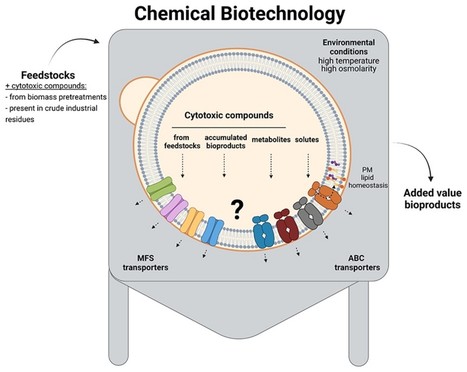



 Your new post is loading...
Your new post is loading...



